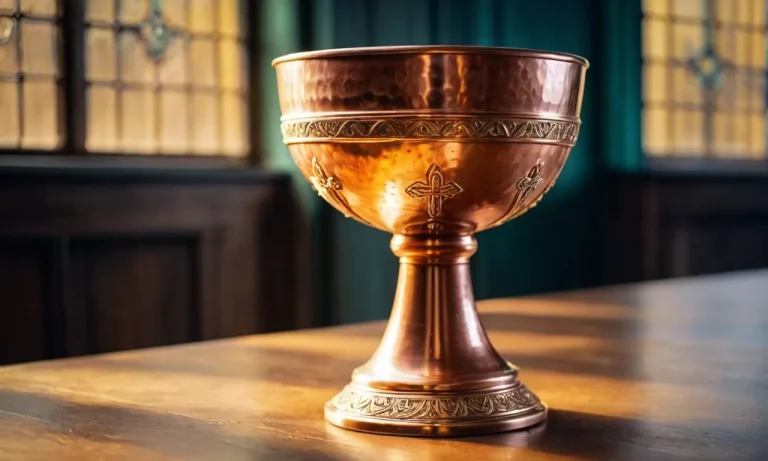The number 3 holds deep spiritual meaning that traces back thousands of years. If you’ve been seeing this number pop up everywhere lately, it’s a clear sign there’s divine guidance trying to get your attention. In this comprehensive guide, we’ll explore the history and symbolism of the number 3 to help you unlock its spiritual secrets.
At its core, the number 3 represents the principle of increase and manifestation. It’s the number of divine harmony, wisdom, understanding, and completion. Keep reading to learn about the religious, mythological, and mystical significance of 3, and how you can apply its energy in your own life.
Religious and Mythological Symbolism of 3
Throughout history, the number 3 has held great significance in various religious and mythological traditions. Let’s explore some of the fascinating symbolism associated with this number.
Christianity
In Christianity, the number 3 holds immense spiritual significance. It is closely tied to the Holy Trinity, representing the three persons of God – the Father, the Son (Jesus Christ), and the Holy Spirit. This concept of the Trinity is central to Christian theology and is believed to symbolize the unity and completeness of God.
Biblical stories also often incorporate the number 3. For example, Jesus Christ’s resurrection occurred on the third day after his crucifixion, emphasizing the theme of rebirth and redemption.
Hinduism
In Hinduism, the number 3 represents the Trimurti, which consists of three major deities: Brahma (the creator), Vishnu (the preserver), and Shiva (the destroyer). These three deities are believed to be responsible for the creation, sustenance, and dissolution of the universe, respectively. The Trimurti is a fundamental concept in Hindu mythology and symbolizes the cyclical nature of existence.
Another significant aspect of the number 3 in Hinduism is the concept of triveni sangam, which refers to the confluence of three sacred rivers. The most famous triveni sangam is the meeting point of the Ganges, Yamuna, and Saraswati rivers in Allahabad, India. This convergence is considered highly auspicious and is believed to cleanse one’s sins.
Other Mythological Traditions
Various other mythological traditions also attribute important symbolism to the number 3. In Norse mythology, there were three primary realms: Asgard (the realm of the gods), Midgard (the realm of humans), and Helheim (the realm of the dead). This tripartite division represented the interconnectedness of these realms and the balance between different aspects of existence.
In ancient Greek mythology, the Moirai, also known as the Fates, were a trio of goddesses who controlled the destinies of individuals. Clotho spun the thread of life, Lachesis measured it, and Atropos cut it, representing the stages of birth, life, and death.
It is fascinating to observe how the number 3 appears repeatedly in various religious and mythological traditions. Its presence signifies harmony, balance, and completeness, reminding us of the interconnectedness of different aspects of our existence.
Trinities in Major World Religions
The concept of a trinity, or a group of three divine beings or forces, is found in several major world religions. These trinities often represent different aspects of the divine and hold significant spiritual meaning. Let’s explore some of the prominent trinities in different religious traditions.
The Holy Trinity in Christianity
One of the most well-known trinities is the Holy Trinity in Christianity, which consists of God the Father, God the Son (Jesus Christ), and God the Holy Spirit. This trinity symbolizes the three-in-one nature of God, with each person representing a distinct aspect of the divine. The Father is seen as the creator and sustainer, the Son as the redeemer and savior, and the Holy Spirit as the guide and comforter. The Holy Trinity is a central doctrine in Christianity and is a source of great spiritual contemplation and devotion for believers.
The Trimurti in Hinduism
In Hinduism, the Trimurti is the trinity of supreme deities, consisting of Brahma the creator, Vishnu the preserver, and Shiva the destroyer. Each deity represents a different cosmic function and aspect of the divine. Brahma is associated with creation, Vishnu with preservation and harmony, and Shiva with destruction and transformation. The Trimurti reflects the cyclical nature of existence and the interplay between creation, preservation, and dissolution. Devotees of Hinduism see the Trimurti as the ultimate expression of divinity and find deep spiritual significance in their worship.
The Triple Gems in Buddhism
In Buddhism, the Triple Gems, also known as the Three Jewels, are the Buddha, the Dharma, and the Sangha. The Buddha represents the enlightened teacher who guides the path to liberation, the Dharma refers to the teachings and the truth of the Buddhist path, and the Sangha is the community of practitioners who support and inspire each other. Together, the Triple Gems form the foundation of Buddhist practice and serve as a source of refuge and inspiration for followers. The Triple Gems symbolize the pursuit of enlightenment and the path to liberation from suffering.
The Triple Goddess in Neopaganism
Neopaganism, a modern religious movement, often incorporates the concept of the Triple Goddess. This trinity consists of the Maiden, the Mother, and the Crone, representing the stages of a woman’s life and the cycles of nature. The Maiden embodies youth, new beginnings, and potential, the Mother represents fertility, nurturing, and abundance, and the Crone symbolizes wisdom, transformation, and the completion of the life cycle. The Triple Goddess is revered as a symbol of feminine power and the interconnectedness of life.
These are just a few examples of the trinities found in major world religions. They serve as reminders of the multifaceted nature of the divine and offer believers a deeper understanding of spiritual concepts. Exploring these trinities can enhance our appreciation for the diverse ways in which people seek and experience spiritual meaning.
3 in Numerology and Angel Numbers
The Significance of the Number 3 in Numerology
Numerology is the study of numbers and their symbolic meanings. In numerology, the number 3 holds a special significance. It is considered to be a powerful and highly spiritual number. The number 3 is associated with creativity, self-expression, and communication. It represents the energy of expansion, growth, and abundance.
When the number 3 appears in your life, it is believed to be a sign from the universe that you are in alignment with your true purpose and that you are on the right path. It is a reminder to embrace your creativity and express yourself authentically. The number 3 is often seen as a positive and optimistic number, bringing joy, enthusiasm, and a sense of adventure.
Angel Numbers and the Number 3
In addition to its significance in numerology, the number 3 is also considered to be an angel number. Angel numbers are believed to be messages from the divine realm, guiding and supporting us on our spiritual journey.
When you repeatedly see the number 3, it is a sign that the angels are trying to get your attention. They are encouraging you to tap into your creative abilities and express yourself freely. The angels are reminding you of your inherent power to manifest your desires and create a life that brings you joy and fulfillment.
Angel number 3 is often associated with the presence of Ascended Masters and spiritual guides. It is a sign that they are supporting you and guiding you towards spiritual enlightenment. When you see this number, take a moment to connect with your spiritual team and ask for their guidance and assistance.
Examples of the Number 3 in Spirituality
The number 3 can be found in various spiritual traditions and teachings. In Christianity, the Holy Trinity represents the Father, Son, and Holy Spirit. In Hinduism, the Trimurti symbolizes the three aspects of the Supreme Being – Brahma, Vishnu, and Shiva. In Buddhism, the Triple Gem represents the Buddha, the Dharma, and the Sangha.
Furthermore, many ancient civilizations recognized the power of the number 3. The ancient Egyptians believed in the trinity of Osiris, Isis, and Horus. The ancient Greeks revered the three Fates – Clotho, Lachesis, and Atropos – who controlled the thread of human destiny. These examples highlight the universal significance and spiritual meaning attributed to the number 3.
The Number 3 in Tarot
In Tarot, the number 3 is associated with creativity, expansion, and growth. It represents the manifestation of ideas and the birth of something new. The number 3 is often seen as a symbol of harmony and equilibrium, as it combines the energies of the numbers 1 and 2.
The Three of Cups
One of the most significant cards in the Tarot deck that is associated with the number 3 is the Three of Cups. This card often depicts three women raising their cups in celebration, representing joy, friendship, and abundance. It signifies a time of connection and emotional fulfillment. When this card appears in a reading, it suggests that positive relationships and celebrations are on the horizon.
The Empress
Another card in the Tarot deck that is closely tied to the number 3 is The Empress. She is the embodiment of fertility, abundance, and creativity. The Empress represents the nurturing and motherly aspects of life, and she encourages us to tap into our own creative potential. When The Empress appears in a reading, it may indicate a time of growth and abundance in our personal and professional lives.
The Trinity
The number 3 is also associated with the concept of the Trinity in many spiritual traditions. The Trinity represents the threefold nature of the Divine, often depicted as the Father, Son, and Holy Spirit in Christianity. It symbolizes unity, balance, and the interconnectedness of all things. The number 3 reminds us that there is power in collaboration and cooperation, as we bring together different energies and perspectives to create something greater than ourselves.
3 in Alchemy, Geometry, and Nature
The number 3 holds great significance in various fields, including alchemy, geometry, and nature. Let’s explore how this mystical number manifests in these realms.
Alchemy
In alchemy, the number 3 represents the three essential stages of transformation: nigredo (blackening), albedo (whitening), and rubedo (reddening). These stages symbolize the process of purifying and perfecting oneself or an object. Alchemists believed that by going through these stages, one could attain spiritual enlightenment and transmute base metals into gold. The number 3 also relates to the three primary alchemical principles: sulfur, mercury, and salt, which represent the triadic nature of the universe.
Geometry
Geometry, the study of shapes and their properties, also recognizes the significance of the number 3. The triangle, with its three sides and three angles, is a fundamental shape in geometry. It is the simplest polygon and represents stability, harmony, and balance. The equilateral triangle, with its three equal sides, is often associated with spiritual symbolism and can be found in various sacred geometrical patterns.
Moreover, the number 3 is connected to the concept of the trinity in many religious and spiritual traditions. It symbolizes the union of opposites and the creation of something new. Whether it is the Father, Son, and Holy Spirit in Christianity, the Triple Goddess in Wicca, or the three Gunas in Hinduism, the number 3 signifies a divine and transformative power.
Nature
In nature, the number 3 is abundant and can be observed in various aspects. From the three primary colors (red, blue, and yellow) that combine to form all other colors to the three phases of the moon (waxing, full, and waning), the number 3 reflects the inherent balance and rhythm of the natural world.
Furthermore, many plants and animals exhibit the significance of the number 3. For example, clovers are often associated with luck due to the presence of three leaves, and trillium flowers have three petals. In the animal kingdom, trinities can be found in the three primary colors of butterflies’ wings, the three divisions of an insect’s body (head, thorax, and abdomen), and the three sections of a bird’s wing (humerus, ulna, and radius).
By recognizing the spiritual meaning of the number 3 in alchemy, geometry, and nature, we can gain a deeper understanding of the interconnectedness of the universe and our place within it. The power of this number invites us to embrace transformation, seek harmony, and appreciate the beauty of the natural world.
Conclusion
The number 3 is packed with spiritual power and wisdom. Throughout history, it has represented the principles of increase, manifestation, harmony, and completion. Seeing this number repetitively is a clear message from the universe to pay attention to areas of your life that need growth, expression, balance, and fulfillment.
Use the energetic properties of 3 as your guidepost going forward. Meditate on its meanings, and look for opportunities to apply them in your spiritual practice. The deeper awareness and enlightenment you seek is closer than you realize. With the angelic power of 3 on your side, you have all you need to achieve profound understanding and evolve to a higher state of being.






